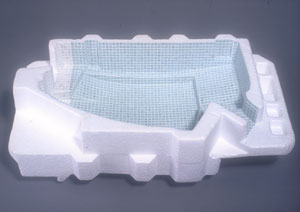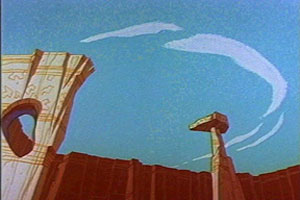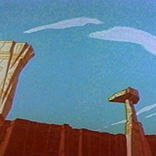The title of this show initially alarmed me, but Going West doesn’t shove the Western Myth down your throat in obvious ways. Unexpected materials, variable scales, changing light, humor, and a dreamy idealism make this show, curated by ArtHouse's Erin Keever, highly entertaining.
Overall, this group uses intelligence and wit to twist the idea of the American West to suit each artist’s abilities and interests. Mungo Thomson’s video room is great. He has removed Wylie E. Coyote from the Chuck Jones Road Runner cartoons. As I stood and watched the barren but colorful landscapes drift by, 3 other visitors walked in and said, “Where is the Road Runner?” It was comforting to hear the predictable and consistent response: comforting to hear others say what I had also said to myself, like being at a concert. By removing the dynamic protagonist from these familiar cartoon landscapes, the viewer can finally enjoy the strong composition and great color saturation that always lay behind the action. It deconstructs and nicely reveals a strong detail of a commonplace but complex item.
Sagebrush, by Bale Creek Allen, is a deceptively complex piece. It looks exactly like a dried-out ball of sagebrush, but is actually an intricate cast bronze piece. Allen says it took five artists two months to cast and attach each tiny branch to the piece. That’s a lot of twigs. Bronze is an expensive material that is meant to stand the test of time, and in Allen’s hands it becomes a test of the longest possible time spent constructing an elaborate homage to one very minor player in the Western landscape (as opposed to the famous, heroic Western bronzes of cowboys and Indians on horseback). It’s pretty, well made, strong, and ridiculous. Why not dip a real one in resin? Because that wouldn’t be as funny. And it would be way too easy.

Katrina Moorhead... Someone Else’s Salton Sea (Moonmist), 2001... Styrofoam, polymer, glue, grout... 5” x 17” x 10”
In the hot, dry climate of the West, swimming pools are either a necessity or a luxury, depending on whom you talk to. Katrina Moorhead’s piece Someone Else’s Salton Sea is carved out of a Styrofoam insert from a shipping box — perhaps from a computer. The Styrofoam has been coated with tiny tiles that have been cut and grouted to form a fancy Jacuzzi. Like an elegant dollhouse, the piece draws you in with its obsession to miniature detail and its superior craftsmanship. Possession of water, and envy for other people’s water, is an ongoing theme in the West, and the famous Salton Sea in California is part of the one-two punch (the other part being the Colorado River) that keeps Southern California in the wet. But the Salton Sea, like most residents of California, is a relatively new arrival: it was formed in 1905 when massive flooding caused the Colorado River to temporarily break through an irrigation canal. Since then, the Sea has continued to exist due to agricultural return flows and the efforts of environmentalists. So the Sea, like every swimming pool in the West, is a luxurious anomaly to be rigorously defended; whereas, left to its own devices, it would have dried up long ago.
Bill Davenport’s paintings document icons of the American West. One painting depicts an oil refinery in a tight, shiny landscape. Tempting as it is to ascribe to the painting a dark commentary on industrialism, the loss of the frontier, or manifest destiny, the painting is far too cheerful to admit such gloom: it’s good weather, and the pipes sink into the concrete in such a pleasingly orderly manner. If Davenport is trying to be ironic, his sunny aesthetic is overpowering any caustic message imbedded in his paintings. The same is true of his still life painting of old dime store books and magazines. If Davenport is trying to deliver a message about the potency of cheapo bourgeois magazines like “American West,” again, his careful technique belies him. Whatever meaningful content was contained in these middle-American, 70’s throwaway books is subsumed to Davenport’s conscientious formal technique.
Kyle Wadsworth took over two of ArtHouse’s walls for a site-specific installation of a cowboy with a shotgun and a father holding his son, both made of pink plastic tape. He projected the images on the walls and then cut out all the pieces with X-acto blades. Wadsworth, a proud Texan man who’s not afraid to use pink, approached the flat graphic work through materials first, process second, image third. He claims Pink Panther cartoons and the 50’s TV show The Rifleman as inspiration. The ‘wall treatment’ is kitschy, big and bright, and is enjoyable to look at.
Teresa O’Connor’s horse photographs and miniature horses in tiny mountains resonated with me deeply. Like many Western girls, I collected Breyer horses as a child, and wove little thread bridles for them. I could write a whole essay just about girls and horses and fantasy and art, but I’ll just say that they are funny and well-crafted.
The humor of these artists and the curator is apparent throughout the show. I’ve heard artists say that group shows are mostly about the curator. If that’s true, then Keever is an eclectic and optimistic comedian. Regardless of the relevance to the theme of Going West, most of these folks hit a conceptual nail squarely on the head. A moment of comprehension followed by a burst of laughter is priceless.
Going West is on view at the Galveston Art Center May 29 – June 11, 2004.
Images courtesy the artists and ArtHouse.
Rachel Koper is an artist and writer living in Austin.





